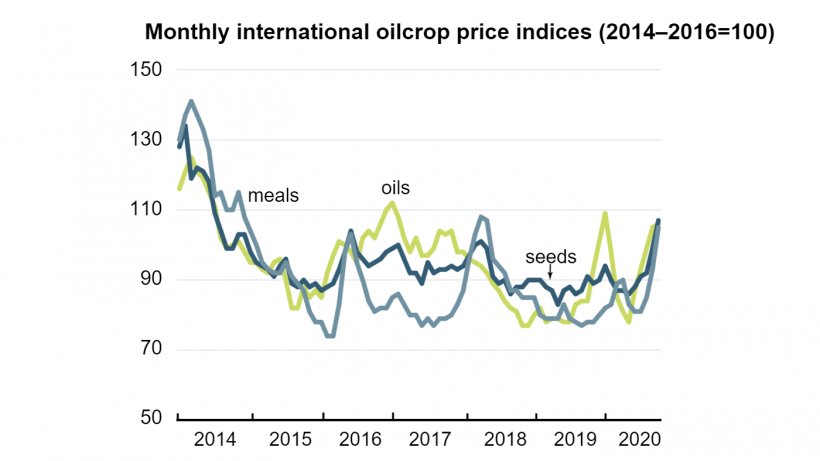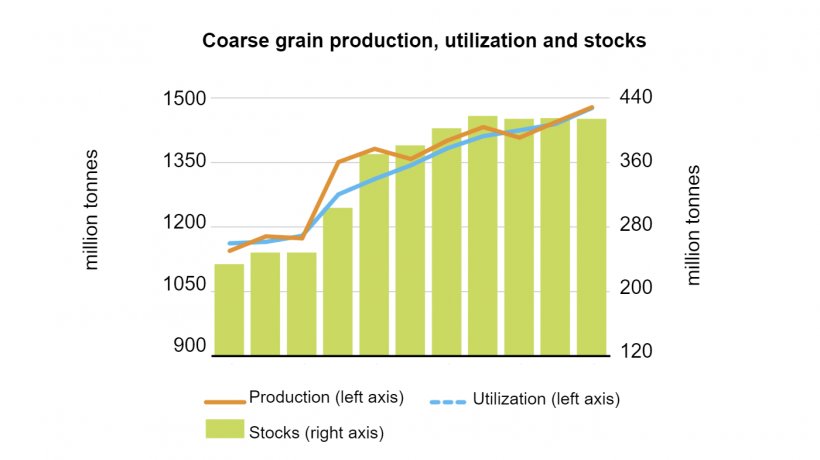Global coarse grain production and trade to rise
The forecast for global coarse grains production in 2020 points to a 2.4% increase from 2019 to a record 1 478 millions tonnes. Maize production is seen to rise by 1.9% to an all-time high, pegged at 1 160 million tonnes, largely driven by expectations of strong production rebounds in the USA and South Africa, as well as record harvests in Argentina and Brazil.

Total coarse grain utilization is heading to a new peak in 2020/21, forecast at 2 745 million tonnes, up 2.6% from 2019/20. Feed use of maize is seen rising by 1.6%, boosted by anticipated strong demand in Argentina, Brazil and China. Global feed use of barley is expected to expand by 3.6%, while strong growth in sorghum feed use in China, driven by high domestic maize prices, is expected to push up global sorghum feed use by almost 16%.
Global inventories in 2020/21 will likely drop slightly, amounting to 0.2% below their opening levels. A 2.5% drop in world maize stocks is forecast to result from anticipated sharp drawdowns of maize inventories in China and, to a lesser extent, the EU.
World trade in coarse grains in 2020/21 (July/June) is forecast to rise 4.7% year-on-year. A foreseen significant increase in maize purchases by China, driven by stronger feed demand and soaring domestic prices, as well as larger imports by the EU following a reduced harvest, could boost maize trade by 3.7%. Likewise, an anticipated rise in sorghum imports by China is seen to lift global trade in sorghum, while expectations of higher barley import demand in the EU and Morocco should drive up world barley trade.
Oilseed production to reach new record
Preliminary forecasts for the 2020/21 season point towards a tightening supply-demand situation for oilseeds and their derived products. After registering a marked decline in 2019/20, global oilseed production is forecast to climb to a new record in 2020/21, underpinned by a pronounced increase in soybean production. In the USA, soybean output is set to rebound strongly, while in Brazil, unusually attractive production margins are anticipated to stimulate plantings. On the other hand, global sunflower seed output could fall to a three-year low owing to detrimental weather conditions in the Black Sea region, while global rapeseed production could remain depressed due to a third consecutive production decline in the EU. Regarding palm oil, global production is forecast to resume growing in 2020/21, after 2019/20’s exceptional decrease caused by, inter alia, the aggravation of migrant labour shortages in the major producing countries in the wake of the COVID-19 pandemic.

On the demand side, in 2020/21, global oils/fats consumption is forecast to resume growing, following COVID-19-related stagnation in the food and non-food sectors in 2019/20. For meals/cakes, global utilization is expected to rise modestly for a second successive season, as world demand for feed continues to recover from the effects of African swine fever outbreaks in Asia. World trade in oilcrop products is poised to grow at below average rates. Based on current forecasts, global utilization of both oils and meals would slightly exceed world production, possibly triggering additional drawdowns in national inventories in 2020/21, while global stock-to-use ratios for oilcrop products would drop below the levels observed in 2019/20.
International quotations for both oilseeds and derived products increased markedly in recent months. Looking forward, prices in the oilcrops complex are expected to be influenced by the further evolvement of the COVID-19 situation, as well as by weather conditions in South America and Southeast Asia (in particular regarding the imminent La Niña cycle), international trade policies, mineral oil prices and the direction of national biodiesel programmes.
FAO. 2020. Food Outlook - Biannual Report on Global Food Markets – November 2020. Rome. https://doi.org/10.4060/cb1993en





